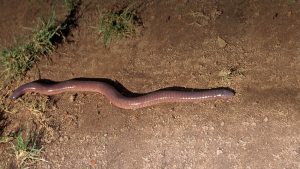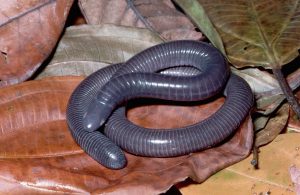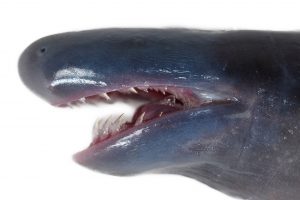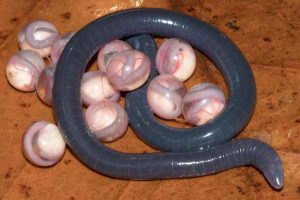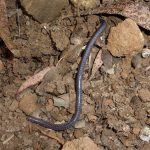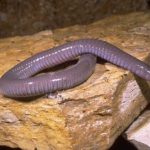Caecilians
Caecilians are native to South and Central America, Southern Asia, and Africa. They are limbless and blind belonging to the amphibian group of Gymnophiona. ‘Caecus’- the Latin word is the origin of their name caecilian, actually meaning blind. This is in reference to their lack of visual power. They also have a strong skull along with a pointed snout. This characteristic feature is one of their adaptations to move smoothly under mud and soil.
1. Rhinatrematidae (American Tailed/ Beaked/ Neotropical Tailed Caecilians) |
||
| Two-colored caecilian (E. bicolor) | El Tambo caecilian (E. columbianus) | Eastern Peru caecilian (E. lativittatus) |
| Marbled caecilian (E. marmoratus) | Black caecilian (E. niger) | Parker’s caecilian (E. parkeri) |
| Marcapata Valley caecilian (E. peruvianus) | Peters’ caecilian (E. petersi) | Two-lined caecilian (R. bivittatum) |
| Shiv’s rhinatrema (R. shiv) | Ron’s rhinatrema (R. ron) | |
2. Ichthyophiidae (Fish/ Asiatic Tailed Caecilians) |
||
| Broad-striped caecilian (C. asplenia) | Larut Hills caecilian (C. larutensis) | Kuala Lumpur caecilian (C. nigroflava) |
| Kapahiang caecilian (C. paucidentula) | Malatgan River caecilian (C. weberi) | Pointed-headed caecilian (I. acuminatus) |
| Long Bloee caecilian (I. atricollaris) | Banna caecilian (I. bannanicus) | Yellow-striped caecilian (I. beddomei) |
| Indonesian caecilian (I. bernisi) | Angular caecilian (I. biangularis) | Billiton Island caecilian (I. billitonensis) |
| Daribok’s striped caecilian (I. daribokensis) | Bombay caecilian (I. bombayensis) | Chorla giant striped caecilian (I. davidi) |
| Mount Dulit caecilian (I. dulitensis) | Elongated caecilian (I. elongates) | Garo Hills caecilian (I. garoensis) |
| Basilan Island caecilian (I. glandulosus) | Ceylon caecilian (I. glutinosus) | Humphrey’s caecilian (I. humphreyi) |
| Husain’s caecilian (I. husaini) | Bantam caecilian (I. hypocyaneus) | Javan caecilian (I. javanicus) |
| Khumhzi striped caecilian (I. khumhzi) | Kodagu striped caecilian (I. kodaguensis) | Koa Tao Island caecilian (I. kohtaoensis) |
| Upper Laos caecilian (I. laosensis) | Long-headed caecilian (I. longicephalus) | Malabar caecilian (I. malabarensis) |
| Mindanao Island caecilian (I. mindanaoensis) | Western Borneo caecilian (I. monochrous ) | Manipur moustached caecilian (I. moustakius) |
| Pattipola caecilian (I. orthoplicatus) | Siantar caecilian (I. paucisulcus) | Ichthyophis peninsularis |
| Taylor’s caecilian (I. pseudangularis) | Sendenyu striped caecilian (I. sendenyu) | Sikkimese caecilian (I. sikkimensis) |
| Singapore caecilian (I. singaporensis) | Ichthyophis subterrestris | Sumatran caecilian (I. sumatranus) |
| Supachai’s caecilian (I. supachaii) | Three-colored caecilian (I. tricolor) | Doi Suthep caecilian (I. youngorum) |
| Gansi caecilian (U. gansi) | Kerala caecilian (U. interruptus) | Malabar tailed caecilian (U. malabaricus) |
| Menon’s caecilian (U. menoni) | Narayan’s caecilian (U. narayani) | Bonnacord caecilian (U. oommeni) |
| Red caecilian (U. oxyurus) | ||
3. Scolecomorphidae (African/ Tropical Caecilians) |
||
| Bornmuller’s caecilian (C. bornmuelleri) | Mont Oku caecilian (C. lamottei) | Crotaphatrema tchabalmbaboensis |
| Lake Tanganyika caecilian or Kirk’s caecilian (S. kirkii) | Nyingwa caecilian or Uluguru black caecilian (S. uluguruensis) | Banded caecilian or Ribbon caecilian (S. vittatus) |
4. Herpelidae (African Caecilians) |
||
| Boulenger’s/ Usambara bluish-gray caecilian (Boulengerula boulengeri) | Changamwe/ Changamwe lowland/ Changamwensis African caecilian (Boulengerula changamwensis) | Denhardt’s African caecilian (Boulengerula denhardti) |
| Fischer’s African caecilian (Boulengerula fischeri) | Sagalla caecilian (Boulengerula niedeni) | Spawls’ boolee (Boulengerula spawlsi) |
| Taita Mountains/ Taita Hills/ Taita African caecilian (Boulengerula taitana) | Uluguru African/ Uluguru pink caecilian (Boulengerula uluguruensis) | Victoria caecilian (H. multiplicata) |
| Congo caecilian (H. squalostoma) | ||
5. Chikilidae (Indian Caecilians) |
||
| Chikila alcocki | Chikila darlong | Fuller’s/ Kuttal caecilian (Chikila fuller) |
| Chikila gaiduwani | ||
6. Caeciliidae (Common Caecilians) |
||
| Brasilotyphlus braziliensis
|
Mimosiphonops reinhardti | Mimosiphonops vermiculatus |
| Brasilotyphlus guarantanus | Caecilia abitaguae | Caecilia albiventris |
| Antioquia caecilian (Caecilia antioquiaensis) | Caecilia armata | Caecilia attenuata |
| Caecilia bokermanni | Caecilia caribea | Caecilia corpulenta |
| Caecilia crassisquama | Garagoa caecilian (Caecilia degenerata) | Caecilia disossea |
| Dunn’s caecilian (Caecilia dunni) | Caecilia flavopunctata | Caecilia gracilis |
| Caecilia guntheri | Fundo Sinchona caecilian (Caecilia inca) | Caecilia isthmica |
| Caecilia leucocephala | Caecilia marcusi | Mertens’ caecilian (Caecilia mertensi) |
| Rio Lita caecilian (Caecilia nigricans) | Caecilia occidentalis | Caecilia orientalis |
| Caecilia pachynema | Caecilia perdita | Caecilia pressula |
| Caecilia subdermalis | Caecilia subnigricans | Caecilia subterminalis |
| Caecilia tentaculata | Caecilia tenuissima | Thompson’s caecilian (Caecilia thompsoni) |
| Caecilia volcani | Microcaecilia albiceps | Microcaecilia dermatophaga |
| Microcaecilia grandis | Microcaecilia rabei | Microcaecilia supernumeraria |
| Microcaecilia taylori | Microcaecilia unicolor | Microcaecilia marvaleewakeae |
| Parvicaecilia nicefori | Parvicaecilia pricei | Aleku caecilian or Ethiopian caecilian (Sylvacaecilia grandisonae) |
| Pastaza River caecilian (Oscaecilia bassleri) | Yavisa caecilian (Oscaecilia elongata) | Equatorial caecilian (Oscaecilia equatorialis) |
| Joinville caecilian (Oscaecilia hypereumeces) | Quisto Cocha caecilian (Oscaecilia koepckeorum) | Yellow-headed caecilian (Oscaecilia ochrocephala) |
| Airstrip/ Osa caecilian (Oscaecilia osae) | New Granada caecilian (Oscaecilia polyzona) | Tributary caecilian (Oscaecilia zweifeli) |
7. Typhlonectidae (Aquatic Caecilians) |
||
| Atretochoana eiselti | Chthonerpeton arii | Chthonerpeton braestrupi |
| Bahia caecilian (C. exile) | Argentine caecilian (C. indistinctum) | Chthonerpeton noctinectes |
| Chthonerpeton onorei | Minas Gerais caecilian (C. perissodus) | Santa Catarina caecilian
(C. viviparum) |
| Nectocaecilia petersii | Potomotyphlus kaupii | Cayenne caecilian (T. compressicauda ) |
| Rubber eels (Typhlonectes natans) | ||
8. Indotyphlidae (Common Caecilians) |
||
| Pink blind/ blind/ Periya Peak caecilian (Gegeneophis carnosus) | Amboli/ Daniel’s caecilian (Gegeneophis. danieli) | Goa caecilian ( Gegeneophis. goaensis) |
| Gurupur caecilian (Gegeneophis krishni) | Mudur caecilian (Gegeneophis madhavai) | Gegenophis mhadeiensis |
| Nadkarnii caecilian (Gegeneophis nadkarnii) | Forest/ Ramaswami’s/ Tenmalai blind/ Tenmalai caecilian (Gegeneophis ramaswamii) | Seshachari’s caecilian (Gegeneophis seshachari) |
| Grandisonia alternans | Grandisonia larvata | Grandisonia sechellensis |
| Hypogeophis brevis | Frigate Island caecilian (H. rostratus) | Makumunu Assumbo caecilian (I. russeli) |
| Battersby’s caecilian (I. battersbyi) | Maharashtra/ Humbarli / Konkan tail-less caecilian (I. maharashtraensis) | Praslin’s caecilian (P. cooperi) |
| Aleku/ Ethiopian caecilian (S. grandisonae) | ||
9. Siphonopidae (Common Caecilians) |
||
| Caecilita iwokramae/ Microcaecilia iwokramae
|
São Paulo caecilian (Luetkenotyphlus brasiliensis) | Ringed caecilian (Siphonops annulatus) |
| Hardy’s caecilian (Siphonops hardyi) | Insular Caecilian (Siphonops insulanus) | Salvador caecilian (Siphonops leucoderus) |
| Boettger’s caecilian (Siphonops paulensis) | ||
10. Dermophiidae (Common Caecilians) |
||
| Dermophis costaricense | Dermophis glandulosus
|
Dermophis gracilior
|
| Mexican burrowing caecilian (Dermophis mexicanus) | Oaxacan caecilian (Dermophis oaxacae) | Dermophis occidentalis |
| La Loma/ Slender caecilian (Dermophis parviceps) | Angel’s caecilian (Geotrypetes angeli) | False angel’s caecilian (Geotrypetes angeli) |
| False angel’s caecilian (Geotrypetes pseudoangeli) | Gaboon caecilian (Geotrypetes seraphini) | Varagua/ purple caecilian (Gymnopis multiplicata) |
| Mountain/ wet forest caecilian (Gymnopis syntrema) | Mud-dwelling/ Witu/ flood-plain-dwelling caecilian (Schistometopum gregorii) | Sao Tome/ São Tomé/ São Thomé/ island/ cobra bobo/ Aqua Ize caecilian (Schistometopum thomense) |
Habitat: Where Do Caecilians Live
Most caecilians are burrowers, living under swampy lands
while there are some American species, known as aquatic caecilians as they live
in streams and rivers.
What Do They Eat
Researchers have found detritus from their body, implying
they are carnivores. Not much is known about their diet, but it is believed
that with their sharp teeth, caecilians are able to consume mollusks. Along
with that, they eat termites, earthworms, lizards, beetle pupae, and small
snakes.
Reproduction and Life Cycle
Male caecilians with their phallodeum, an intromittent
organ, generate and deliver sperm into the cloaca of female caecilians. The
internal insemination process lasts for two to three hours. While most species
are viviparous, they give birth to young caecilians.
However, a few species are oviparous as they lay eggs in
damp and moist burrows or holes. The egg-laying female protects the eggs
throughout. While some are born fully developed, some go through the
metamorphosis process post their birth. Some larvae are semi-aquatic, and they
roam near water bodies, sometimes going into the water for eating planktons.
Gradually, their skin thickens and sensible tentacles develop as they reach
adulthood.
Threats and Predators
Snakes, turtles, and crocodiles are common predators of
caecilians.
Interesting Facts
- Caecilians are the only known amphibians to have
tentacles. - They are also the only amphibian species to mate
through internal insemination. - Viviparous caecilians have a unique way, known
as dermatotrophy, of feeding their unborn babies (foetus). The mother grows nutrient
and fat enriched skin in her oviduct (the part starts from her ovary and reaching
outside). This skin is consumed by the young caecilians with their hook-like
teeth. - For closing their jaws, many caecilians species
have two sets of muscles. This is an adaptation for making burrows, where they
need to have their jaws and skull firm. - One particular species, Typhlonectes natans is incorrectly known as Rubber eels. Sometimes
at aquarium stores, this species is enlisted and sold as a fish. - Only one species, known as Atretochoana eiselti
doesn’t have lungs. Those who have lungs, also breath through skin and mouth.
